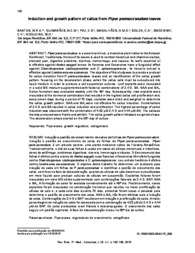Induction and growth pattern of callus from Piper permucronatum leaves.
Induction and growth pattern of callus from Piper permucronatum leaves.
Author(s): SANTOS, M. R. A. dos; GUIMARÃES, M. C. M.; PAZ, E. S.; MAGALHÃES, G. M. O.; SOUZA, C. A.; SMOZINSKI, C. V.; NOGUEIRA, W. O.
Summary: Piper permucronatum is a perennial shrub, a medicinal plant native to the Amazon Rainforest. Traditionally, the tea of its leaves is used to combat menstrual and intestinal cramps, stomach pain, digestive problems, diarrhea, hemorrhage, and nausea. Its leaf?s essential oil is effective against Aedes aegypti larvae; its flavones and flavanones have a fungicidal effect against Clamidosporium cladosporioides and C. sphaerospermum; its hexanic extract is effective against Leishmania amazonensis. The objective of this study was to provide a protocol for callus induction from P. permucronatum leaves and an identification of the callus growth pattern, focusing on the deceleration phase, when the callus cells must be subcultured into liquid medium in order to produce a cell suspension cultures. Leaf explants were inoculated in a solid MS medium supplemented with factorial combinations of 2,4-D, BA, NAA and GA3. Callus formation was evaluated weekly until the 49th day. Subsequently, new explants were inoculated at the hormonal combination that resulted in the highest callus cell proliferation and, every seven days during a period of 70 days, samples were dried and weighed to determine the callus growth pattern. NAA and GA3 were not effective for callus induction. Combinations of 2,4-D and BA resulted in callus induction and proliferation. The highest percentage of callus induction was observed with the combination of 4.52 µM 2,4-D and 4.44 µM BA. The calluses thereby produced were friable and whitish. The callus growth pattern followed a sigmoid shape. The deceleration phase started on the 56th day of culture.
Publication year: 2016
Types of publication: Journal article
Unit: Embrapa Rondônia
Observation
Some of Embrapa's publications are published as ePub files. To read them, use or download one of the following free software options to your computer or mobile device. Android: Google Play Books; IOS: iBooks; Windows and Linux: Calibre.
Access other publications
Access the Agricultural Research Database (BDPA) to consult Embrapa's full library collection and records.
Visit Embrapa Bookstore to purchase books and other publications sold by Embrapa.

